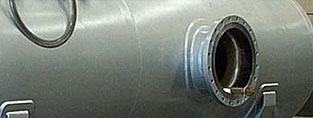
- (03) 5909 8218
- enquiry@fusionweld.com.au
Common Stress Problems in Thin Walled Pressure Vessels
September 23, 2016

The curved surface of a thin walled pressure vessel flexes in response to planar stress, but design engineering excellence addresses this pressure-induced force by assessing common stress problems. A state of equilibrium is then achieved by offsetting the tug and push of opposing wall strain. It's a balancing act, undoubtedly, but this mechanical parity challenge is simplified when established system constants influence the design. Geometrical profiles and wall thickness values equate with those constants, so which external stress variables require deliberation?
Identifying and Defining Hoop Stress
This tangential stress factor runs around the circumference of the vessel due to the outward push precipitated by a pressurized fluid. The strain works at an angle perpendicular to the actual vessel wall. As with other problems of this nature, the force acts uniformly all the way around the circumference of the storage container's wall, so it is a calculable problem, one that's directly affected by the volume of the container, its flexing characteristics, and the compressibility of the storage medium.
Geometry Rules Thin Walled Pressure Vessels
There are other stressors in vessel design. Longitudinal energy is simultaneously straining the vessel while tangential hoop force pushes at the weld joints of the rolled alloy. Yet another problem, radial stress, is related to hoop problems, but the energy is proceeding outward from a central internalized force-distributing node, not making itself known as uniform circumferential strain, which is the case with hoop issues. Of course, these problems relate to a cylinder with semispheroidal end caps, so weld technology is also being subjected to some scrutiny in this scenario, especially at the end caps and the roll join.
Common Stress Problems of Fluids
Engineering science is a mix of constants and variables, all wrapped up in the close-fitting laws of Physics. We've gone some way here to determining the effects of opposing mechanical forces, but what of the fluid? Heat exchangers, for instance, add additional stress when energy is imparted to a liquid. Excess energy also causes state changes, from liquid water to steam, perhaps, or from one catalyzing chemical to another. Common stress problems, therefore, are also generated by the characteristics and energy states of the fluid medium being stored and/or processed.
A diligent design engineer constructs thin walled pressure vessels to exacting standards, shapes, and mechanical profiles. They address the various mechanical strains present and the effects of the internally stored fluid medium. Additionally, external forces and environmental stresses represent the final stressor, a factor that can cause parts to wear, contract and expand.
Contact Details
Fusion - Weld Engineering Pty Ltd
ABN 98 068 987619
1865 Frankston Flinders Road,
Hastings, VIC 3915
Ph: (03) 5909 8218
Optimized by NetwizardSEO.com.au
Recent Posts
- Compressed Hydrogen Storage Vessels: Material Selection, Design & Australian Standards
- Welding QA/QC in Oil & Gas Pressure Vessel Fabrication – Ensuring Code Compliance
- AS1210 vs ASME VIII Pressure Vessel Code: Key Differences for Australian Projects
- Mitigating Hydrogen-Induced Cracking in Pressure Vessels: Engineering and Material Strategies
- Storage Tank Solutions Australia: Field-Erected, Prefabricated & Self-Bunded Explained
- Reducing Environmental Risks: Self-Bunded Tanks in Australian Oil & Gas Operations
- Precision in Production: How Pressure Vessels Are Manufactured for Industrial Safety
- Shell & Tube Heat Exchangers: Improve Thermal Control & Energy Recovery in Petrochemical & Pharmaceutical Plants
- In-Service Inspection for Compressed Air Receivers for Power Plant Shutdown Prevention
- Power Plant Pipe Spooling Fabrication – Get Rapid, Code-Compliant Spools Ready for Installation
- Field Erected Tanks: Safe, Reliable On-Site Fuel Storage Solutions in Australia
- Custom Pressure Vessel Fabrication for Flammable Gases
Posts 2025
- Compressed Hydrogen Storage Vessels: Material Selection, Design & Australian Standards
- Welding QA/QC in Oil & Gas Pressure Vessel Fabrication – Ensuring Code Compliance
- View all articles…
Posts 2024
- Large Process Vessels: Optimising the Design for Maximum Efficiency [2025]
- Pressure Equipment Management System Installation: Detect Equipment Faults Early
- View all articles…
Posts 2023
- Pressure Piping System Inspection: A Gift of Safety for the Holidays
- Deaerator Inspections by Fusion-Weld Engineering and How They Reduce System Downtime
- View all articles…
Posts 2022
- How Fusion Weld Keeps Up With AS-NZS ISO 9001:2008 Standard
- Boiler Equipment Safety Inspection During the Summer Season
- View all articles…
Posts 2021
- Avoid These Factors and Practices that Contribute to Sealing Damage in Pressure Vessels
- Do's And Don'ts Of Industrial Boiler Inspection And Maintenance From Fusion-Weld
- View all articles…
Posts 2020
- What are the Risks and Hazards Involved in Pressure Vessel Equipment?
- How to Know if Your Pressure Equipment Needs Repair or Replacement?
- View all articles…
Posts 2019
- Factors that Contribute to Pressure Vessel Failure
- Pressure Vessel Regulations in Australia: What are the Mandatory Requirements?
- View all articles…
Posts 2018
- Pros and Cons of Spherical vs. Cylindrical Pressure Vessels
- What are the Different Hazard Levels in Pressure Vessels?
- View all articles…
Posts 2017
- Transportable Pressure Vessels: The Importance of Inspection and Safety Checks
- Fracture Mechanics and Stress Analysis of Cracks in Pressure Vessels
- View all articles…
Posts 2016
Posts 2015
- What Are Deaerators & Feedwater Vessels?
- Precautions and Safety for Compressed Air Receiver Vessels
- View all articles…
Posts 2014
- Demonstrating In-process Inspection Procedures
- Static Grounding Practices and Standards
- View all articles…